Abstract
Apparent central apnoea (absent breathing movements) detected by monitoring movement of the thoracic wall was compared with simultaneous detection by abdominal wall movement. Eighteen infants provided one or more 24 hour recording of heart rate (electrocardiography), thoracic respiration (transthoracic impedance), and abdominal wall movement (pressure sensitive capsule distortion). Detection of true apnoea, recognition of artefact, and measurement of the duration of true apnoea were all improved when two channels of respiratory monitoring were used in combination. We recommend that any study purporting to observe breathing patterns by indirect recording of respiratory movement will be more reliable if more than one channel of respiratory movements is recorded simultaneously. Further, in infants no estimation of duration of central apnoea can be made on the basis of either a transthoracic impedance record alone or an abdominal wall movement sensor alone. Comparison of findings among studies using different single channel recordings are unlikely to be meaningful.
Full text
PDF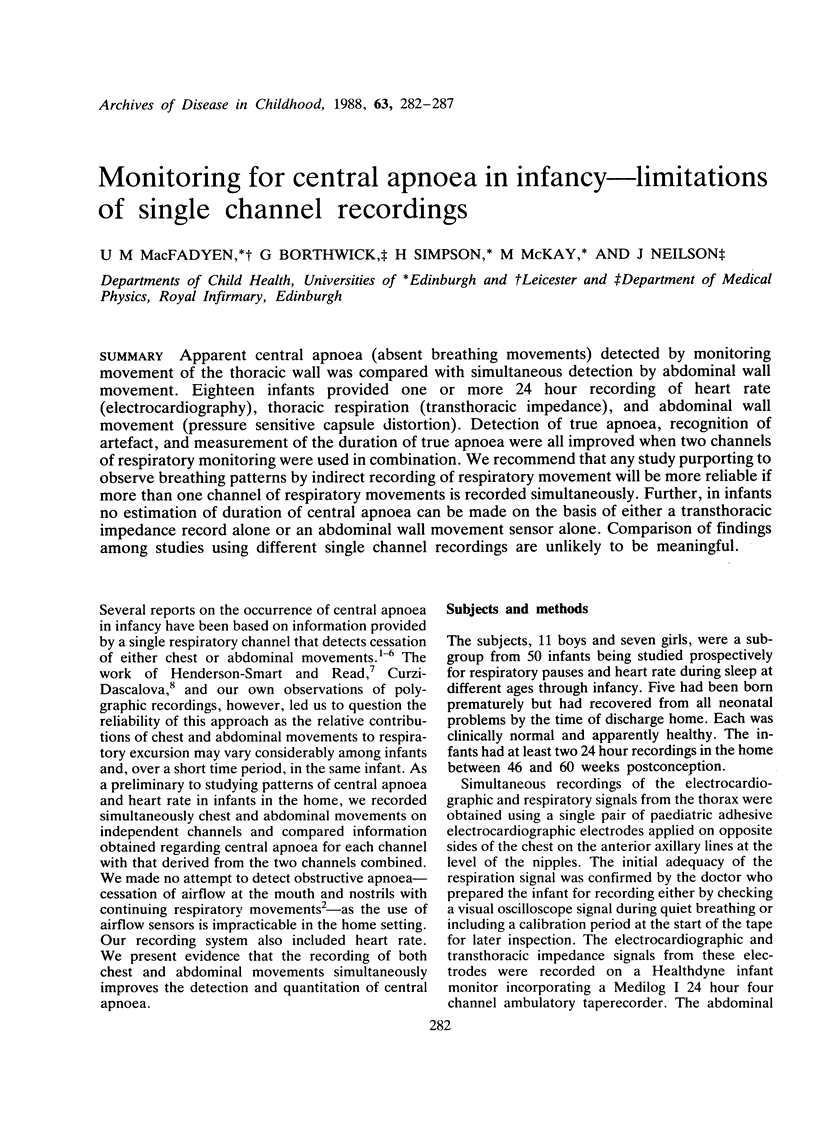
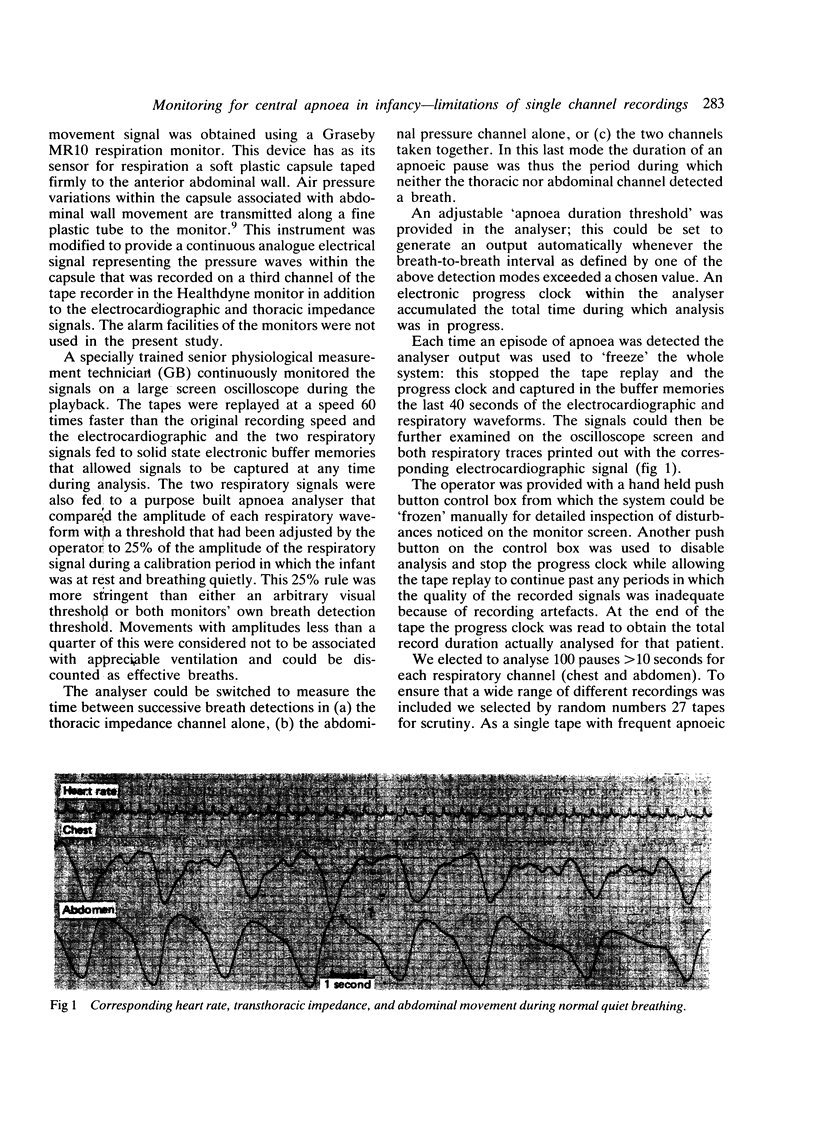
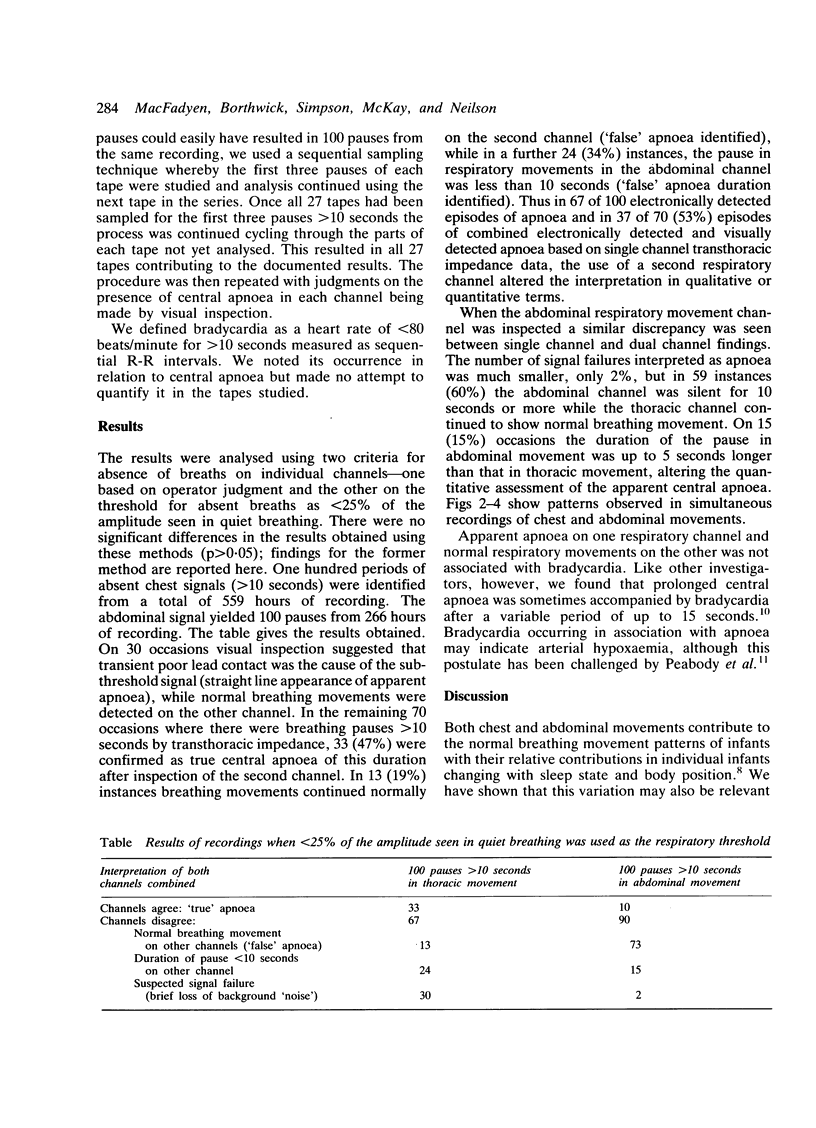
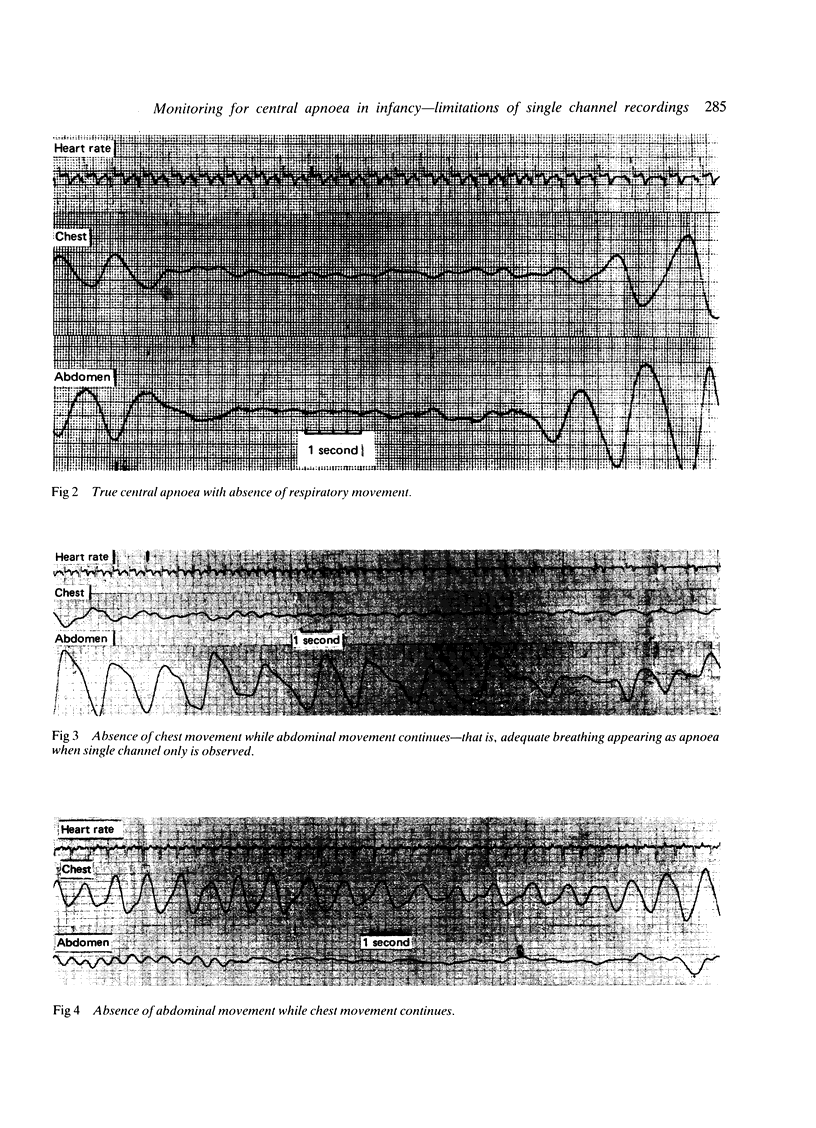
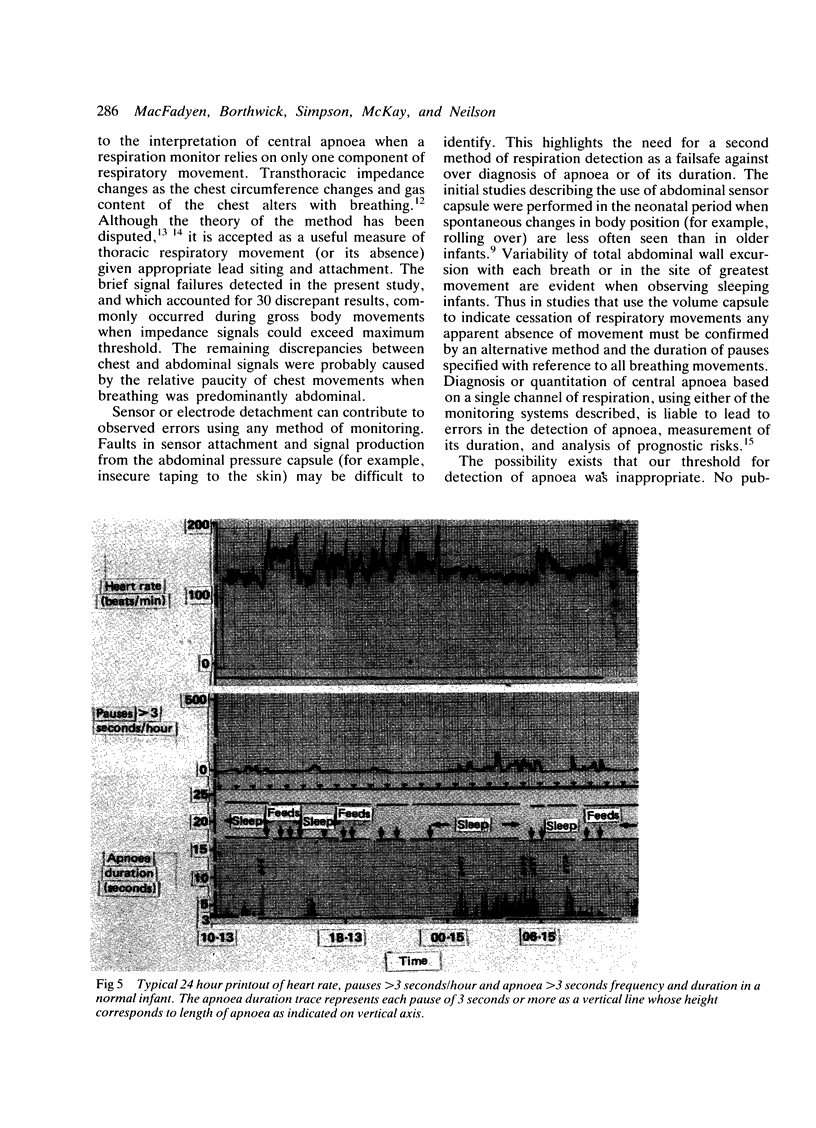
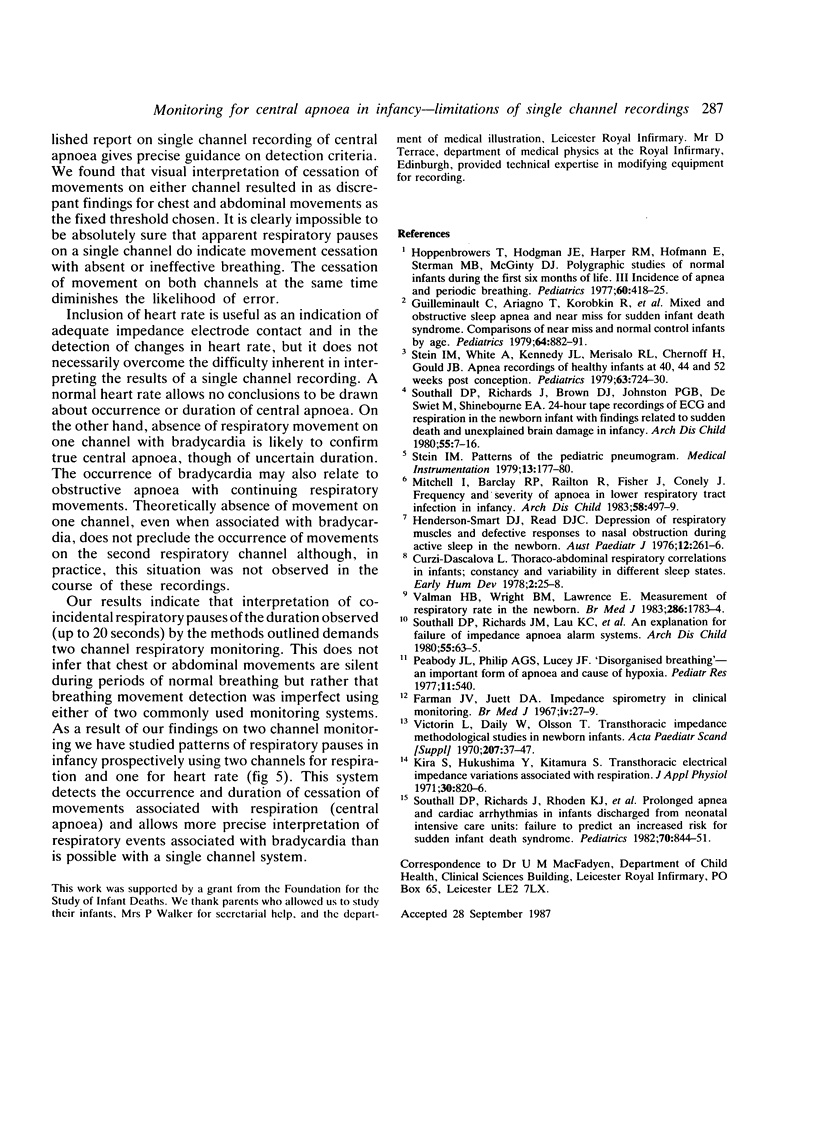
Images in this article
Selected References
These references are in PubMed. This may not be the complete list of references from this article.
- Curzi-Dascalova L. Thoracico-abdominal respiratory correlations in infants: constancy and variability in different sleep states. Early Hum Dev. 1978 Apr;2(1):25–38. doi: 10.1016/0378-3782(78)90050-6. [DOI] [PubMed] [Google Scholar]
- Farman J. V., Juett D. A. Impedance spirometry in clinical monitoring. Br Med J. 1967 Oct 7;4(5570):27–29. doi: 10.1136/bmj.4.5570.27. [DOI] [PMC free article] [PubMed] [Google Scholar]
- Guilleminault C., Ariagno R., Korobkin R., Nagel L., Baldwin R., Coons S., Owen M. Mixed and obstructive sleep apnea and near miss for sudden infant death syndrome: 2. Comparison of near miss and normal control infants by age. Pediatrics. 1979 Dec;64(6):882–891. [PubMed] [Google Scholar]
- Henderson-Smart D. J., Read D. J. Depression of respiratory muscles and defective responses to nasal obstruction during active sleep in the newborn. Aust Paediatr J. 1976 Dec;12(4):261–266. doi: 10.1111/j.1440-1754.1976.tb02513.x. [DOI] [PubMed] [Google Scholar]
- Hoppenbrouwers T., Hodgman J. E., Harper R. M., Hofmann E., Sterman M. B., McGinty D. J. Polygraphic studies of normal infants during the first six months of life: III. Incidence of apnea and periodic breathing. Pediatrics. 1977 Oct;60(4):418–425. [PubMed] [Google Scholar]
- Kira S., Hukushima Y., Kitamura S., Ito A. Transthoracic electrical impedance variations associated with respiration. J Appl Physiol. 1971 Jun;30(6):820–826. doi: 10.1152/jappl.1971.30.6.820. [DOI] [PubMed] [Google Scholar]
- Mitchell I., Barclay R. P., Railton R., Fisher J., Conely J. Frequency and severity of apnoea in lower respiratory tract infection in infancy. Arch Dis Child. 1983 Jul;58(7):497–499. doi: 10.1136/adc.58.7.497. [DOI] [PMC free article] [PubMed] [Google Scholar]
- Olsson T., Victorin L. Transthoracic impedance, with special reference to newborn infants and the ratio air-to-fluid in the lungs. Acta Paediatr Scand Suppl. 1970;207(Suppl):1+–1+. [PubMed] [Google Scholar]
- Southall D. P., Richards J. M., Lau K. C., Shinebourne E. A. An explanation for failure of impedance apnoea alarm systems. Arch Dis Child. 1980 Jan;55(1):63–65. doi: 10.1136/adc.55.1.63. [DOI] [PMC free article] [PubMed] [Google Scholar]
- Southall D. P., Richards J. M., Rhoden K. J., Alexander J. R., Shinebourne E. A., Arrowsmith W. A., Cree J. E., Fleming P. J., Goncalves A., Orme R. L. Prolonged apnea and cardiac arrhythmias in infants discharged from neonatal intensive care units: failure to predict an increased risk for sudden infant death syndrome. Pediatrics. 1982 Dec;70(6):844–851. [PubMed] [Google Scholar]
- Southall D. P., Richards J., Brown D. J., Johnston P. G., de Swiet M., Shinebourne E. A. 24-hour tape recordings of ECG and respiration in the newborn infant with findings related to sudden death and unexplained brain damage in infancy. Arch Dis Child. 1980 Jan;55(1):7–16. doi: 10.1136/adc.55.1.7. [DOI] [PMC free article] [PubMed] [Google Scholar]
- Stein I. M. Patterns of the pediatric pneumogram. Med Instrum. 1979 May-Jun;13(3):177–180. [PubMed] [Google Scholar]
- Stein I. M., White A., Kennedy J. L., Jr, Merisalo R. L., Chernoff H., Gould J. B. Apnea recordings of healthy infants at 40, 44, and 52 weeks postconception. Pediatrics. 1979 May;63(5):724–730. [PubMed] [Google Scholar]
- Valman H. B., Wright B. M., Lawrence C. Measurement of respiratory rate in the newborn. Br Med J (Clin Res Ed) 1983 Jun 4;286(6380):1783–1784. doi: 10.1136/bmj.286.6380.1783. [DOI] [PMC free article] [PubMed] [Google Scholar]







